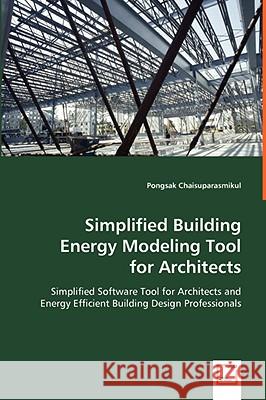Simplified Building Energy Modeling Tool for Architects: Simplified Software Tool for Architects and Energy Efficient Building Design Professionals » książka
Simplified Building Energy Modeling Tool for Architects: Simplified Software Tool for Architects and Energy Efficient Building Design Professionals
ISBN-13: 9783639009774 / Angielski / Miękka / 2008 / 260 str.
Simplified Building Energy Modeling Tool for Architects: Simplified Software Tool for Architects and Energy Efficient Building Design Professionals
ISBN-13: 9783639009774 / Angielski / Miękka / 2008 / 260 str.
(netto: 387,01 VAT: 5%)
Najniższa cena z 30 dni: 390,31 zł
ok. 16-18 dni roboczych.
Darmowa dostawa!
Simplified Building Energy Modeling Tool for Architects is an energy software program designed to study the relative change of energy uses in different architectural design schemes.It can be used in the design process, construction, and daily operation of most buildings. This energy-based interfacing program is intended to help architects, engineers, educators, students, building designers, major consumers of architectural services, and other professionals, whose work interfaces with that of architects, to quickly visualize, and compare energy performance and savings of different design schemes. The techniques are sophisticated enough to inform design decisions, enable performance analysis and diagnostic studies. The book begins with the importance of and outlines its scope of work, problems, hepotheses, innovative approach, objectives, methodology and procedure, assumptions and limitations, research findings, and outcommes and results, takes the readers into a historical development and recent trends of building energy modeling, analysis, and design tools, then explains the major concepts of the software tool: module and its parameters, and many different functions that the tool can do."
Simplified Building Energy Modeling Tool for Architects is an energy software program designed to study the relative change of energy uses in different architectural design schemes.It can be used in the design process,construction, and daily operation of most buildings. This energy-based interfacing program is intended to help architects, engineers, educators, students, building designers, major consumers of architectural services, and other professionals, whose work interfaces with that of architects, to quickly visualize, and compare energy performance and savings of different design schemes. The techniques are sophisticated enough to inform design decisions, enable performance analysis and diagnostic studies.The book begins with the importance of and outlines its scope of work, problems, hepotheses, innovative approach, objectives, methodology and procedure,assumptions and limitations, research findings, and outcommes and results, takes the readers into a historical development and recent trends of building energy modeling, analysis, and design tools, then explains the major concepts of the software tool: module and its parameters, and many different functions that the tool can do.











